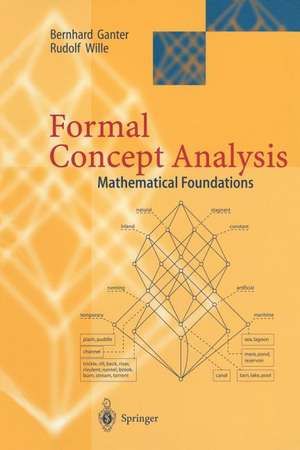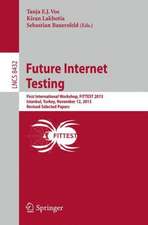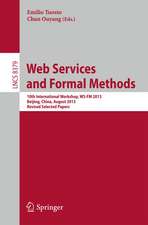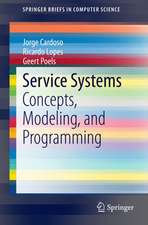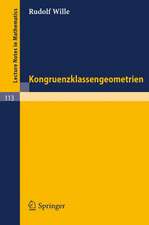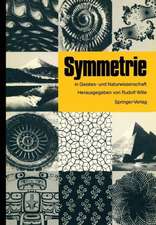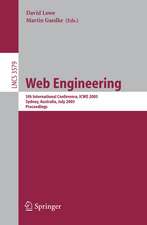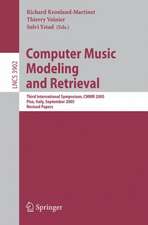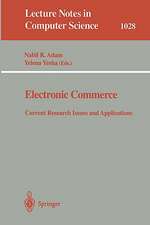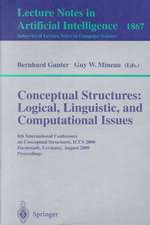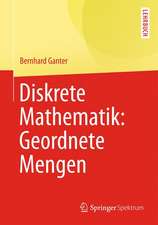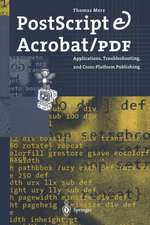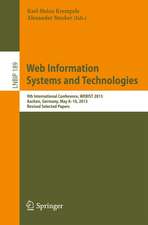Formal Concept Analysis: Mathematical Foundations
Autor Bernhard Ganter Traducere de C. Franzke Autor Rudolf Willeen Limba Engleză Paperback – 4 dec 1998
| Toate formatele și edițiile | Preț | Express |
|---|---|---|
| Paperback (1) | 532.12 lei 43-57 zile | |
| Springer Berlin, Heidelberg – 4 dec 1998 | 532.12 lei 43-57 zile | |
| Hardback (1) | 400.03 lei 43-57 zile | |
| Springer Nature Switzerland – 18 sep 2024 | 400.03 lei 43-57 zile |
Preț: 532.12 lei
Preț vechi: 665.14 lei
-20% Nou
Puncte Express: 798
Preț estimativ în valută:
101.82€ • 106.59$ • 84.25£
101.82€ • 106.59$ • 84.25£
Carte tipărită la comandă
Livrare economică 07-21 aprilie
Preluare comenzi: 021 569.72.76
Specificații
ISBN-13: 9783540627715
ISBN-10: 3540627715
Pagini: 296
Ilustrații: X, 284 p.
Dimensiuni: 155 x 235 x 16 mm
Greutate: 0.43 kg
Ediția:Softcover reprint of the original 1st ed. 1999
Editura: Springer Berlin, Heidelberg
Colecția Springer
Locul publicării:Berlin, Heidelberg, Germany
ISBN-10: 3540627715
Pagini: 296
Ilustrații: X, 284 p.
Dimensiuni: 155 x 235 x 16 mm
Greutate: 0.43 kg
Ediția:Softcover reprint of the original 1st ed. 1999
Editura: Springer Berlin, Heidelberg
Colecția Springer
Locul publicării:Berlin, Heidelberg, Germany
Public țintă
Lower undergraduateCuprins
0. Order-theoretic Foundations.- 0.1 Ordered Sets.- 0.2 Complete Lattices.- 0.3 Closure Operators.- 0.4 Galois Connections.- 0.5 Hints and References.- 1. Concept Lattices of Contexts.- 1.1 Context and Concept.- 1.2 Context and Concept Lattice.- 1.3 Many-valued Contexts.- 1.4 Context Constructions and Standard Scales.- 1.5 Hints and References.- 2. Determination and Representation.- 2.1 All Concepts of a Context.- 2.2 Diagrams.- 2.3 Implications between Attributes.- 2.4 Dependencies between Attributes.- 2.5 Hints and References.- 3. Parts and Factors.- 3.1 Subcontexts.- 3.2 Complete Congruences.- 3.3 Closed Subrelations.- 3.4 Block Relations and Tolerances.- 3.5 Hints and References.- 4. Decompositions of Concept Lattices.- 4.1 Subdirect Decompositions.- 4.2 Atlas-decompositions.- 4.3 Substitution.- 4.4 Tensorial Decompositions.- 4.5 Hints and References.- 5. Constructions of Concept Lattices.- 5.1 Subdirect Product Constructions.- 5.2 Gluings.- 5.3 Local Doubling.- 5.4 Tensorial Constructions.- 5.5 Hints and References.- 6. Properties of Concept Lattices.- 6.1 Distributivity.- 6.2 Semimodularity and Modularity.- 6.3 Semidistributivity and Local Distributivity.- 6.4 Dimension.- 6.5 Hints and References.- 7. Context Comparison and Conceptual Measurability.- 7.1 Automorphisms of Contexts.- 7.2 Morphisms and Bonds.- 7.3 Scale Measures.- 7.4 Measurability Theorems.- 7.5 Hints and References.- References.
Textul de pe ultima copertă
This is the first textbook on formal concept analysis. It gives a systematic presentation of the mathematical foundations and their relations to applications in computer science, especially in data analysis and knowledge processing. Above all, it presents graphical methods for representing conceptual systems that have proved themselves in communicating knowledge. Theory and graphical representation are thus closely coupled together. The mathematical foundations are treated thoroughly and illuminated by means of numerous examples. Since computers are being used ever more widely for knowledge processing, formal methods for conceptual analysis are gaining in importance. This book makes the basic theory for such methods accessible in a compact form.
Caracteristici
Includes supplementary material: sn.pub/extras
Notă biografică
Bernhard Ganter is Emeritus Professor of Mathematics at Technische Universität Dresden, Germany. His main research field is Formal Concept Analysis. Before being appointed to Dresden in 1993, he was a member of R. Wille’s working group and contributed to the development of Formal Concept Analysis. He is co-founder of the “Mathematics Adventure Land” exhibition in Dresden, which has been a success since 2008.
Rudolf Wille (2 November 1937 – 22 January 2017) was professor of Mathematics (General Algebra) from 1970 to 2003 at Technische Universität Darmstadt, Germany. He is cofounder of the celebrated theory of Formal Concept Analysis, a field of mathematics that applies mathematical lattice theory to organize data based on objects and their shared attributes. An accomplished musician, he also made contributions to Mathematics in Music, Mathematical Pedagogy and the Philosophy of Science, and was a leading scholar in the concept lattice research community.
Rudolf Wille (2 November 1937 – 22 January 2017) was professor of Mathematics (General Algebra) from 1970 to 2003 at Technische Universität Darmstadt, Germany. He is cofounder of the celebrated theory of Formal Concept Analysis, a field of mathematics that applies mathematical lattice theory to organize data based on objects and their shared attributes. An accomplished musician, he also made contributions to Mathematics in Music, Mathematical Pedagogy and the Philosophy of Science, and was a leading scholar in the concept lattice research community.
